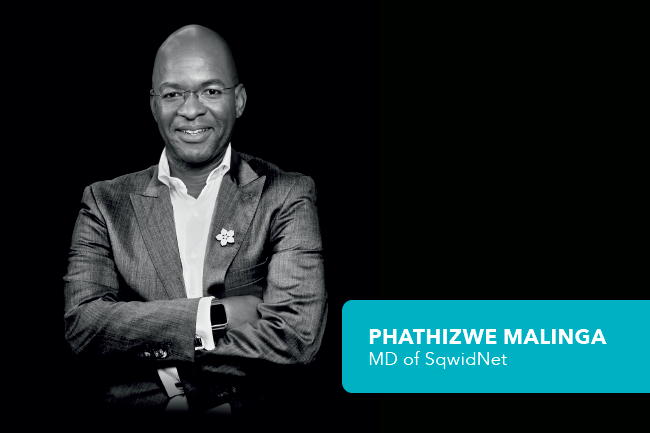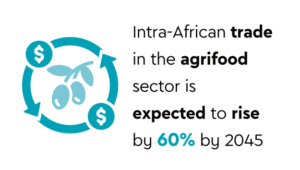Between disruptive developments such as cloud computing, 5G connectivity, FTTX (fibre to the x) and the internet of things, it’s an exciting time for tech companies. For SqwidNet, South Africa’s licensed Sigfox IoT network operator, it’s especially so. ‘With any technology adaption, you get the point where the exponential curve crosses the linear progression,’ says SqwidNet MD Phathizwe Malinga. ‘When it comes to IoT, right now we’re either at the point of disruption, or we’ve gone just past that.’
SqwidNet launched in November 2016 as a wholly owned subsidiary of open-access fibre-connectivity provider DFA. When he talks about the company’s journey, Malinga – who joined SqwidNet as chief solutions officer in mid-2017 – is understandably optimistic. ‘There’s a famous saying by [US entertainer] Eddie Cantor: “It takes a few years of hard work to be an overnight success”,’ he says. ‘I feel like we’re on the verge of becoming an “overnight success”.’
No wonder. SqwidNet has already hit 90% network coverage in South Africa, enabling about 25 million physical devices to be connected to the digital world. ‘When we started we estimated that we would need about 1 500 base stations to make up 85% coverage,’ says Malinga. ‘We achieved it with just 1 000. We recently passed 1 100 base stations, and we plan to put 400 more into South Africa. Now it’s becoming harder and harder to find the gaps.’
After just a year at SqwidNet, Malinga was appointed acting CEO in April 2018, and in September he was confirmed as permanent MD. ‘It feels like a lifetime ago,’ he says. ‘I think because of that period as acting CEO, there hasn’t really been a big change in my day-to-day work. Life carried on.’
As MD, Malinga is responsible for building SqwidNet’s IoT connectivity business in South Africa, in partnership with global giant Sigfox.
He says the demand for collaboration with SqwidNet’s channel partners fits perfectly into his approach to leadership. ‘Our ecosystem is one of the cornerstones of our business,’ he says. ‘It’s in our ethos. We sometimes have run-ins with partners who want exclusivity, where we have to remind them that monopoly will not win in this industry. This industry requires far more capex than we will ever have, and far more opportunities than we could ever master.’
Malinga is well aware of the gap between IoT adaption rates in South Africa compared to the developed world. ‘It’s all about R&D budgets,’ he says. ‘So in terms of the technical things the developed world has played with, they are definitely ahead of South Africa and Africa as a whole. But from a necessity point of view – from the point of view of IoT being practical and working to change businesses – we’re seeing more “mission critical” use cases here than you see overseas. It feels as if overseas IoT is about growth and being the next big thing; whereas here companies are actually using the technology to help them help their customers.’
That’s not to say that IoT isn’t ‘the next big thing’. After years of being a future-tech buzzword, strategic IoT has turned that J-curve, with businesses now taking advantage of strategic IoT to drive innovation and create new revenue opportunities. So how does SqwidNet – and how does Malinga – keep up with pace of change?
He explains that there are three schools of thought when it comes to developing technologies. ‘One says that you need to have your ear to the ground so that you know where the tech is going to go; another says that you need to try to get the tech to go where you want it to go; and then there’s the school of thought that says you should get the two to marry, depending on which is the immovable rock.’
Because it is a relatively new operation, SqwidNet fits the mould of a digital company, ‘even though we’re really an infrastructure company’, adds Malinga. ‘That means we’re agile enough to adjust to where we see the industry going, while also guiding that journey. That would be far more difficult to achieve if we had investments that we couldn’t take with us into that tomorrow.’
Despite the unpredictable nature of the tech space, SqwidNet’s agility allows Malinga to have a clear idea of what the company’s ‘tomorrow’ might look like. ‘We’re hungry for South Africa to use our technology,’ he says. ‘Every day we want to be knocking on a door where someone hasn’t heard of our technology, or they’re overpaying, or they’re still in analogue mode. Right now South Africa has about 25 million IoT devices connected, according to Africa Analysis. A year ago we were at 17 million.
‘We want government, the education sector, everybody, to take full advantage of our network and to use our technology. That’s going to be the next thing for us, and for quite a while.’

















